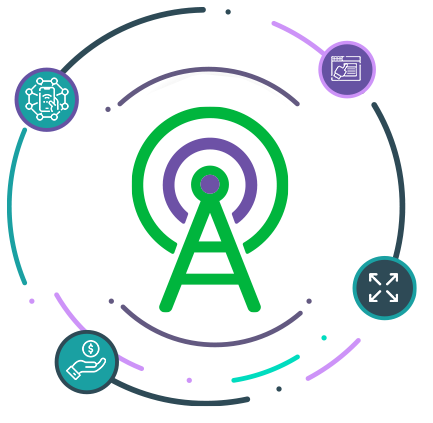The telco industry is constantly evolving, and the need for efficient, scalable, and cost-effective signaling solutions is more crucial than ever. As telecommunications move into the 5G era, network operators are facing the challenges of managing an increasing volume of signaling traffic. Traditional systems like SS7 (Signaling System No. 7) are costly, rigid, and difficult to scale, leading to the adoption of more flexible and cost-efficient technologies like SIGTRAN.
SIGTRAN, which enables SS7 traffic to be transported over IP-based networks, has revolutionized how telcos handle signaling. But while this innovation has opened up new possibilities, it has also introduced the complexity of managing SIGTRAN traffic effectively. To get the most out of this technology, telcos need to have a solid understanding of how to monitor SIGTRAN traffic efficiently.
In this blog, we’ll dive into how you can monitor SIGTRAN traffic like a pro, focusing on the benefits of a robust SIGTRAN Gateway and how to leverage the features of hSenid Mobile’s SIGTRAN Gateway for optimal performance.
Before we explore the nuances of monitoring SIGTRAN traffic, it’s important to understand what SIGTRAN is and why it matters. SIGTRAN is essentially SS7 signaling over IP, which means it allows telcos to transmit signaling messages over Internet Protocol (IP) networks instead of traditional SS7 links. This transformation reduces the need for expensive dedicated lines, making it a more cost-effective solution, especially for telecommunication service providers expanding their networks.
One of the key advantages of SIGTRAN is its ability to seamlessly integrate with existing systems, enabling telcos to scale their services without the need for proprietary hardware like SS7 cards. Moreover, SIGTRAN facilitates faster, more efficient communication, which is crucial for enabling value-added services, such as short message service centers (SMSCs) or location-based services (LBS).
As SIGTRAN continues to power essential services for telecom operators globally, operators need to monitor their SIGTRAN traffic to ensure reliability and optimize performance.
In any large-scale telecom network, managing traffic effectively is crucial. This holds especially true for SIGTRAN networks, where high volumes of signaling data are exchanged. Monitoring SIGTRAN traffic is not as straightforward as monitoring other types of data because it involves several distinct layers and protocols, including the Stream Control Transmission Protocol (SCTP), Signaling Connection Control Part (SCCP), and Transaction Capabilities Application Part (TCAP).
For example, if a telecom operator is running a short message service center (SMSC) or integrating USSD services, SIGTRAN traffic will be key to maintaining service quality. Poorly managed traffic can lead to delays in message delivery, network congestion, or even service interruptions, all of which could have a significant impact on the customer experience.
To address these challenges, you need a robust solution for monitoring SIGTRAN traffic. This is where a SIGTRAN Gateway becomes indispensable. A SIGTRAN Gateway acts as an intermediary between your core network and external applications. It enables the integration of different network layers, provides easy access to signaling data, and offers critical visibility into traffic patterns.
The hSenid Mobile SIGTRAN Gateway, for instance, is a comprehensive, software-based solution that offers several key features:
These features make it much easier for operators to monitor and manage SIGTRAN traffic by providing a more accessible and cost-effective way to integrate signaling across the network.
Now that we’ve established the importance of using a SIGTRAN Gateway for efficient management, let’s explore some best practices for monitoring SIGTRAN traffic effectively.
A SIGTRAN Gateway, like the one from hSenid Mobile, provides API calls for internal applications, which can be integrated with real-time monitoring systems. This allows operators to track traffic and network performance with ease.
Using a SIGTRAN Gateway that provides flow API calls allows operators to monitor traffic flow from one layer to another. By tracking the performance at each layer, you can get a clearer picture of your network’s performance and take action when needed.
In addition, with the flexibility of the hSenid Mobile SIGTRAN Gateway, you can customize alerting mechanisms based on your network’s specific requirements, allowing for more targeted and efficient troubleshooting.
By simulating high traffic volumes and evaluating how your network responds, you can ensure that your SIGTRAN system is prepared to handle any surges in traffic without compromising performance.
Many modern SIGTRAN Gateways, including hSenid Mobile’s solution, provide advanced analytics features that allow you to generate reports on traffic trends. These insights can inform decisions about infrastructure upgrades, traffic routing optimizations, and capacity planning.
As the telecom industry continues to evolve, the need for efficient and scalable solutions like SIGTRAN will only grow. However, managing SIGTRAN traffic requires the right tools and strategies to ensure optimal performance. By using a robust SIGTRAN Gateway, like the one from hSenid Mobile, you can monitor your SIGTRAN traffic effectively, reduce costs, and ensure a seamless experience for your customers.
If you’re looking for a powerful, customizable solution that makes monitoring SIGTRAN traffic easy, look no further than the hSenid SIGTRAN Gateway. With its comprehensive set of features, real-time monitoring capabilities, and cost-effective approach, it’s the perfect choice for telecom operators looking to optimize their signaling infrastructure.
Don’t wait until traffic bottlenecks or performance issues arise, take action today to ensure your SIGTRAN network is running smoothly. Reach out to hSenid Mobile for more information on how hSenid SIGTRAN Gateway can help streamline your signaling processes and improve overall network performance.
SIGTRAN, which enables SS7 traffic to be transported over IP-based networks, has revolutionized how telcos handle signaling. But while this innovation has opened up new possibilities, it has also introduced the complexity of managing SIGTRAN traffic effectively. To get the most out of this technology, telcos need to have a solid understanding of how to monitor SIGTRAN traffic efficiently.
In this blog, we’ll dive into how you can monitor SIGTRAN traffic like a pro, focusing on the benefits of a robust SIGTRAN Gateway and how to leverage the features of hSenid Mobile’s SIGTRAN Gateway for optimal performance.
Understanding SIGTRAN and Its Role in Modern Telecom
Before we explore the nuances of monitoring SIGTRAN traffic, it’s important to understand what SIGTRAN is and why it matters. SIGTRAN is essentially SS7 signaling over IP, which means it allows telcos to transmit signaling messages over Internet Protocol (IP) networks instead of traditional SS7 links. This transformation reduces the need for expensive dedicated lines, making it a more cost-effective solution, especially for telecommunication service providers expanding their networks.
One of the key advantages of SIGTRAN is its ability to seamlessly integrate with existing systems, enabling telcos to scale their services without the need for proprietary hardware like SS7 cards. Moreover, SIGTRAN facilitates faster, more efficient communication, which is crucial for enabling value-added services, such as short message service centers (SMSCs) or location-based services (LBS).
As SIGTRAN continues to power essential services for telecom operators globally, operators need to monitor their SIGTRAN traffic to ensure reliability and optimize performance.
The Challenge of Managing SIGTRAN Traffic
In any large-scale telecom network, managing traffic effectively is crucial. This holds especially true for SIGTRAN networks, where high volumes of signaling data are exchanged. Monitoring SIGTRAN traffic is not as straightforward as monitoring other types of data because it involves several distinct layers and protocols, including the Stream Control Transmission Protocol (SCTP), Signaling Connection Control Part (SCCP), and Transaction Capabilities Application Part (TCAP).
For example, if a telecom operator is running a short message service center (SMSC) or integrating USSD services, SIGTRAN traffic will be key to maintaining service quality. Poorly managed traffic can lead to delays in message delivery, network congestion, or even service interruptions, all of which could have a significant impact on the customer experience.
Why a SIGTRAN Gateway is Key for Effective Monitoring
To address these challenges, you need a robust solution for monitoring SIGTRAN traffic. This is where a SIGTRAN Gateway becomes indispensable. A SIGTRAN Gateway acts as an intermediary between your core network and external applications. It enables the integration of different network layers, provides easy access to signaling data, and offers critical visibility into traffic patterns.
The hSenid Mobile SIGTRAN Gateway, for instance, is a comprehensive, software-based solution that offers several key features:
- Customization: The gateway is designed to be flexible and customizable, which means it can be tailored to meet the specific needs of a telecom operator’s network. The built-in features support the most commonly used signaling functions with minimal overhead, making deployment more cost-effective.
- API Integration: The SIGTRAN Gateway exposes API calls, which enable internal applications to interact with the core network. By supporting two layers of API calls—Direct API calls and Flow API calls—it allows seamless communication with external systems and services.
- Simplified Integration: By eliminating the need for expensive third-party SIGTRAN stacks or SS7 cards, the hSenid Mobile SIGTRAN Gateway offers a more affordable and scalable solution. This makes it easier for operators to integrate SIGTRAN into their existing network infrastructure without requiring significant investment in new hardware.
These features make it much easier for operators to monitor and manage SIGTRAN traffic by providing a more accessible and cost-effective way to integrate signaling across the network.
Best Practices for Monitoring SIGTRAN Traffic
Now that we’ve established the importance of using a SIGTRAN Gateway for efficient management, let’s explore some best practices for monitoring SIGTRAN traffic effectively.
1. Use Real-Time Monitoring Tools
One of the most effective ways to monitor SIGTRAN traffic is by using real-time monitoring tools. These tools provide you with immediate insights into the health of your SIGTRAN network, helping you identify issues as they arise. They can track key metrics such as signaling volumes, message delay times, and response rates, allowing you to spot potential bottlenecks before they become problems.A SIGTRAN Gateway, like the one from hSenid Mobile, provides API calls for internal applications, which can be integrated with real-time monitoring systems. This allows operators to track traffic and network performance with ease.
2. Monitor Traffic Flow
SIGTRAN traffic flows through several layers, including SCTP, SCCP, and TCAP. Each of these layers handles different types of signaling messages, and monitoring each one is crucial to understanding the overall health of your network.Using a SIGTRAN Gateway that provides flow API calls allows operators to monitor traffic flow from one layer to another. By tracking the performance at each layer, you can get a clearer picture of your network’s performance and take action when needed.
3. Track Error Rates and Alerts
Just like any other network protocol, SIGTRAN can experience errors due to congestion, hardware failures, or other issues. Monitoring error rates is crucial to maintaining service quality. With a SIGTRAN Gateway, you can track error messages, such as timeouts, misrouted packets, or malformed messages, and set up alerts to notify you when error rates exceed a certain threshold.In addition, with the flexibility of the hSenid Mobile SIGTRAN Gateway, you can customize alerting mechanisms based on your network’s specific requirements, allowing for more targeted and efficient troubleshooting.
4. Conduct Regular Stress Testing
Stress testing is a vital part of any network monitoring strategy. It helps you assess how your SIGTRAN infrastructure behaves under heavy load and ensures that it can handle traffic spikes. With the scalability and flexibility of a SIGTRAN Gateway, such testing can be done in a more controlled and predictable manner, helping you plan for future growth.By simulating high traffic volumes and evaluating how your network responds, you can ensure that your SIGTRAN system is prepared to handle any surges in traffic without compromising performance.
5. Analyze Trends Over Time
In addition to monitoring real-time traffic, it’s also important to analyze traffic trends over time. By collecting data on signaling patterns, you can identify seasonal spikes, bottlenecks, and network stress points that might not be immediately obvious. This allows you to optimize your network for better performance and plan for future capacity needs.Many modern SIGTRAN Gateways, including hSenid Mobile’s solution, provide advanced analytics features that allow you to generate reports on traffic trends. These insights can inform decisions about infrastructure upgrades, traffic routing optimizations, and capacity planning.
Conclusion: Optimizing Your SIGTRAN Network for Success
As the telecom industry continues to evolve, the need for efficient and scalable solutions like SIGTRAN will only grow. However, managing SIGTRAN traffic requires the right tools and strategies to ensure optimal performance. By using a robust SIGTRAN Gateway, like the one from hSenid Mobile, you can monitor your SIGTRAN traffic effectively, reduce costs, and ensure a seamless experience for your customers.
If you’re looking for a powerful, customizable solution that makes monitoring SIGTRAN traffic easy, look no further than the hSenid SIGTRAN Gateway. With its comprehensive set of features, real-time monitoring capabilities, and cost-effective approach, it’s the perfect choice for telecom operators looking to optimize their signaling infrastructure.
Don’t wait until traffic bottlenecks or performance issues arise, take action today to ensure your SIGTRAN network is running smoothly. Reach out to hSenid Mobile for more information on how hSenid SIGTRAN Gateway can help streamline your signaling processes and improve overall network performance.








